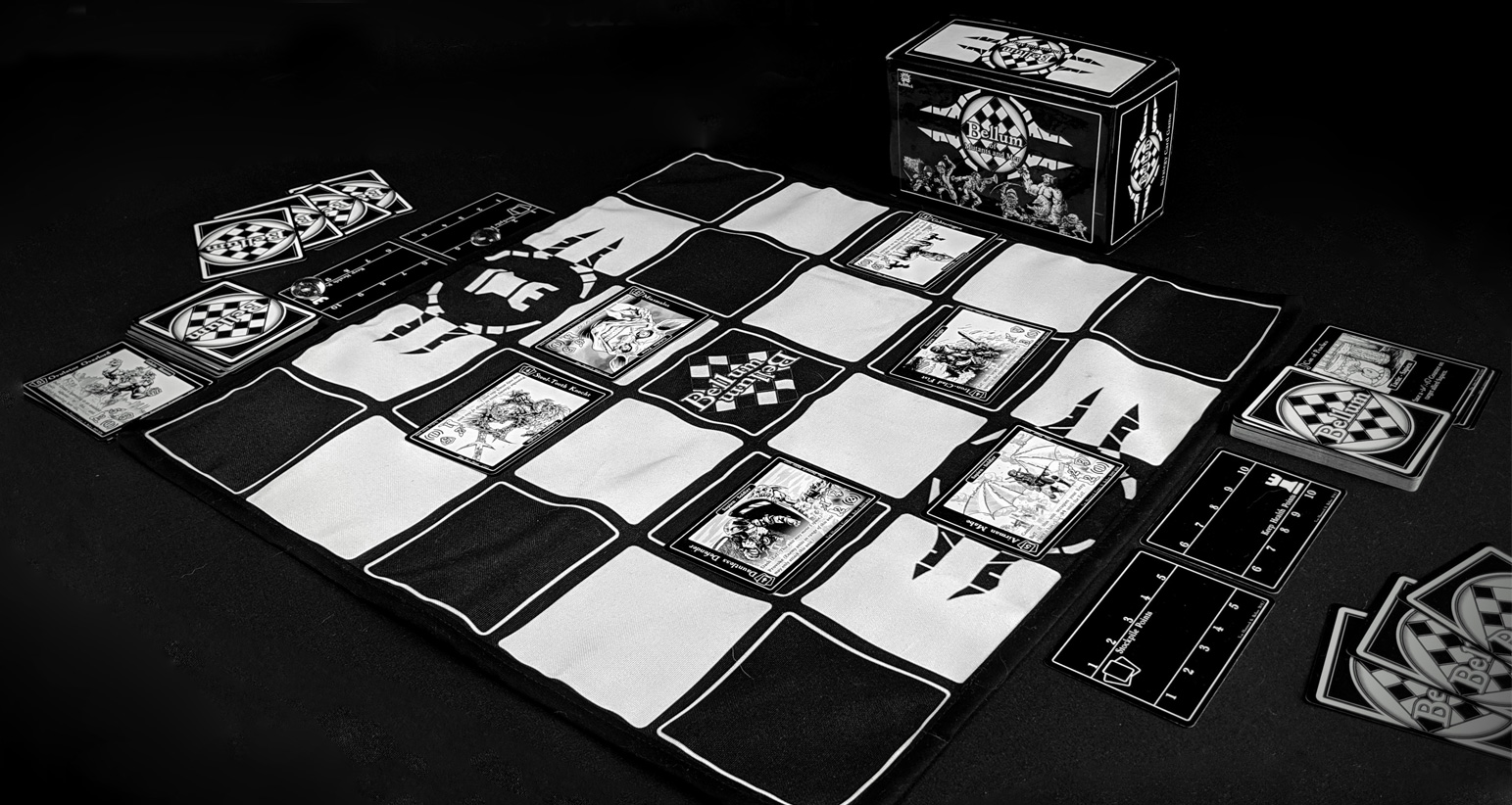| 2 30min |
TLDR: An enjoyable card-battler that’s not too complicated to put off newcomers but with enough variation for seasoned pro’s to sink their teeth into |
This is a special preview of “Bellum: Of Mutants and Men” – a game that is currently being crowdfunded over on Kickstarter. We were sent an early copy of the game to provide feedback as well as share our thoughts on the game with our readers. So it is worth noting that this preview (note, not a ‘review’) is based on an early version of the game and some of the aspects may change slightly before release. However, we are in a position to discuss the gameplay and how well it works so you can decide whether or not to back it on Kickstarter.
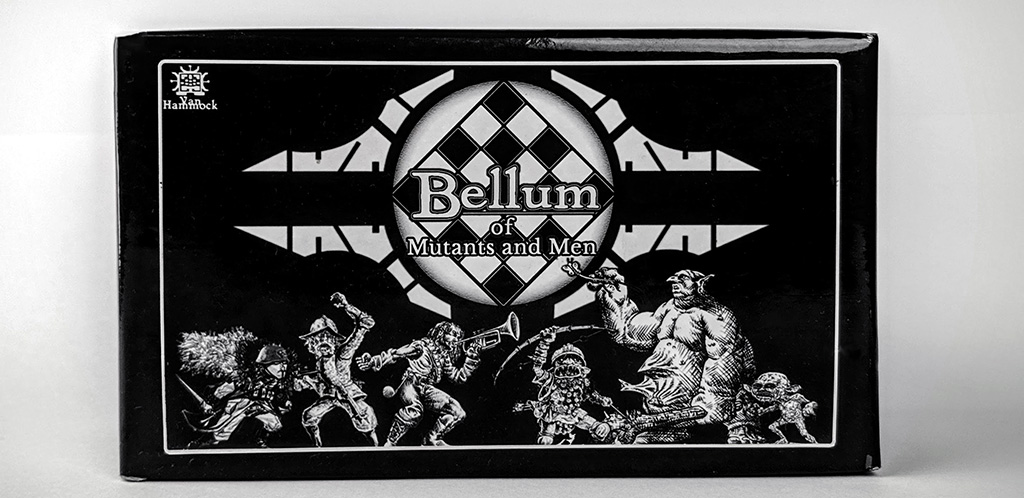
“Bellum: Of Mutants and Men” is a tactical card-battling game for two players – hence our interest! The story of the game is that there are two factions: the Gobalos Colonies (the bad guys) and the Sapien Kingdom (the good guys). The Gobalos are trying to conquer new territory to make room for their ever-multiplying brood while the Sapien kingdom are just trying to survive. As for the game itself, each player has a deck of cards made up of different Units and Stratagem and the aim is to play these on the board in order to attack the enemy and, ultimately, destroy their Keep to win.
As you can tell from the photos the game utilises a black and white theme – the cloth board taking on the look of a chess board and the cards featuring amazing, hand drawn artwork. The artwork is certainly worthy of a special mention: each Unit and Stratagem card includes custom artwork from a number of different artists each with their own unique style. The level of detail is impressive and you can tell that a lot of work has gone into the aesthetics of “Bellum: Of Mutants and Men” as well as the gameplay.
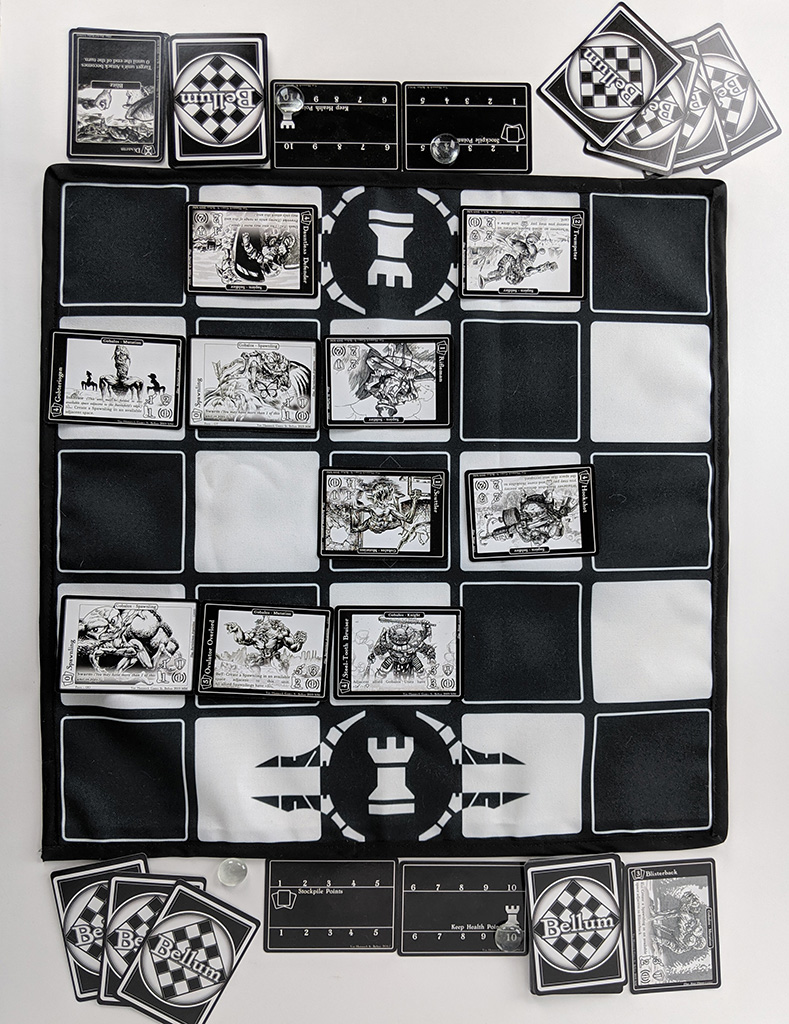
To make things easier for your first game, “Bellum: Of Mutants and Men” includes two pre-built decks of cards – the Sapien Army and the Gobalos Scourge. These consist of 30 cards with a mixture of Unit cards and Stratagem cards and give you a good starter to the game. Also included in the box are another set of each of the starter decks’ cards as well as 116 more cards for players to create their own custom decks – there should be enough to create 8 custom decks. So there are no expansions to buy and no packs of cards to buy to try and get extra Units and abilities.
Strategem cards allow certain actions to take place either at the beginning of a player’s turn (BoT) or at the end (EoT) and these are marked on the cards themselves. The Unit cards also contain pertinent information such as how many squares they can move, their attack and defence levels and their range for attacking.
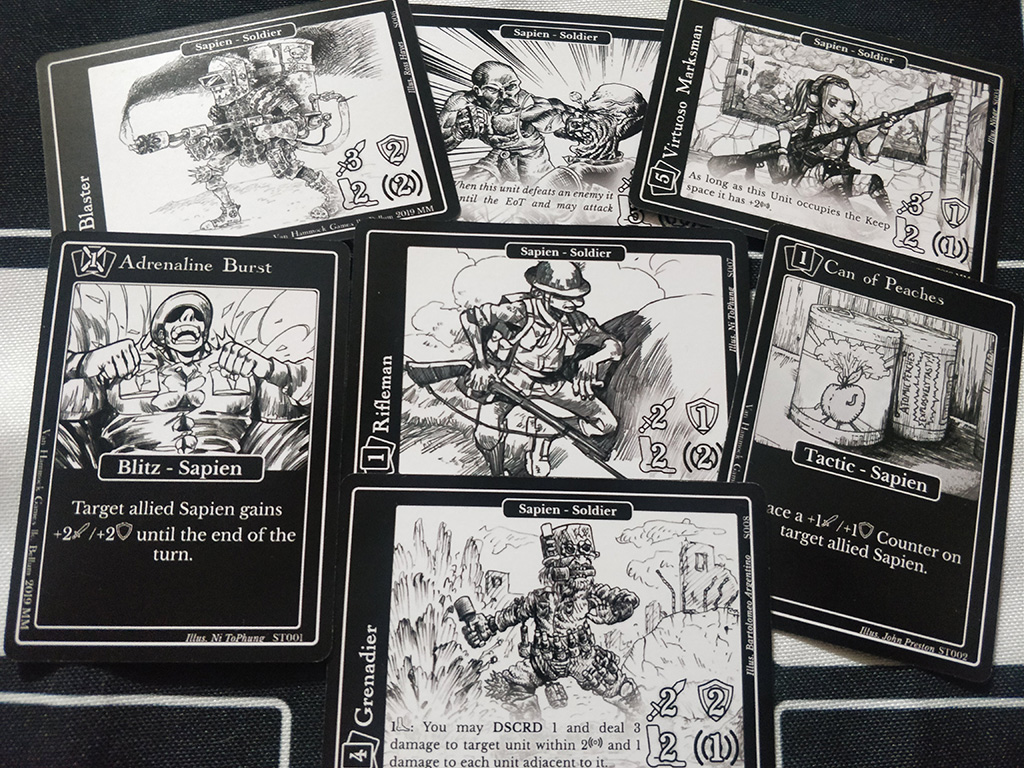
To start the game each player’s deck is shuffled and placed face-down by the board and four cards are removed for the player’s hand. Each player also has a card to place a counter on ‘10’ for the Keep’s strength. There are three parts of each player’s turn: Beginning, Middle and End. At the beginning you carry out any BoT actions from the cards in play and then you calculate your stockpile. The stockpile tells you how many actions you can carry out and is based on the number of cards in your hand – so by collecting more cards you can do more on each turn however having more cards in play will usually mean that you can do less with those cards. It can be a fine balance between the two but this is a skill you will begin to develop after further plays. The middle phase of the turn is where you get to ‘do stuff’. You can field a Unit card (i.e. put a card into play on the board), activate a Unit (i.e. carry out movement or attacking using a Unit or field a Stratagem card. Fielding a Unit or using a Strategem card has an associated ‘cost’ which is removed from your stockpile and the game includes a helpful marker that you can use to mark off when your stockpile is used up on each turn. Players can also choose to skip the middle part and draw a card instead. This has the advantage of giving you extra in your stockpile for your next turn. To end the turn a player activates any EoT actions from Stratagem cards that have been fielded.
During the Middle of Turn phase you can activate any of your fielded cards in any order – but only one unit can be activated at a time. You can move the Units the number of spaces (no diagonals) marked on the card as well as attack the other player’s cards. Once a card’s actions have been carried out it is helpful to rotate the card 90 degrees so you know it can’t be used again that turn. Battles are quite straightforward but do benefit from some advanced planning. To defeat an opponent you simply have to reduce their defence to zero but this can be done across multiple battles and you also need to take your Unit’s range into account. A range of 2 means that the Unit can attack from 2 squares away but if the unit you are attacking only has a range of 1 then they can’t attack you back. Attacks do, however, happen at the same time so there is no advantage for the player that initiates the attack. If an opponent is not defeated after 1 attack (e.g. you attack with ‘1’ but their defence is ‘2’) then you need to remember that the card’s defence is then reduced until the end of the turn. This means you can then plan to attack with a second Unit in order to finish it off. Like I said, it can require some advanced planning to work out the best order to attack and make sure you don’t lose your Unit in the battle too.
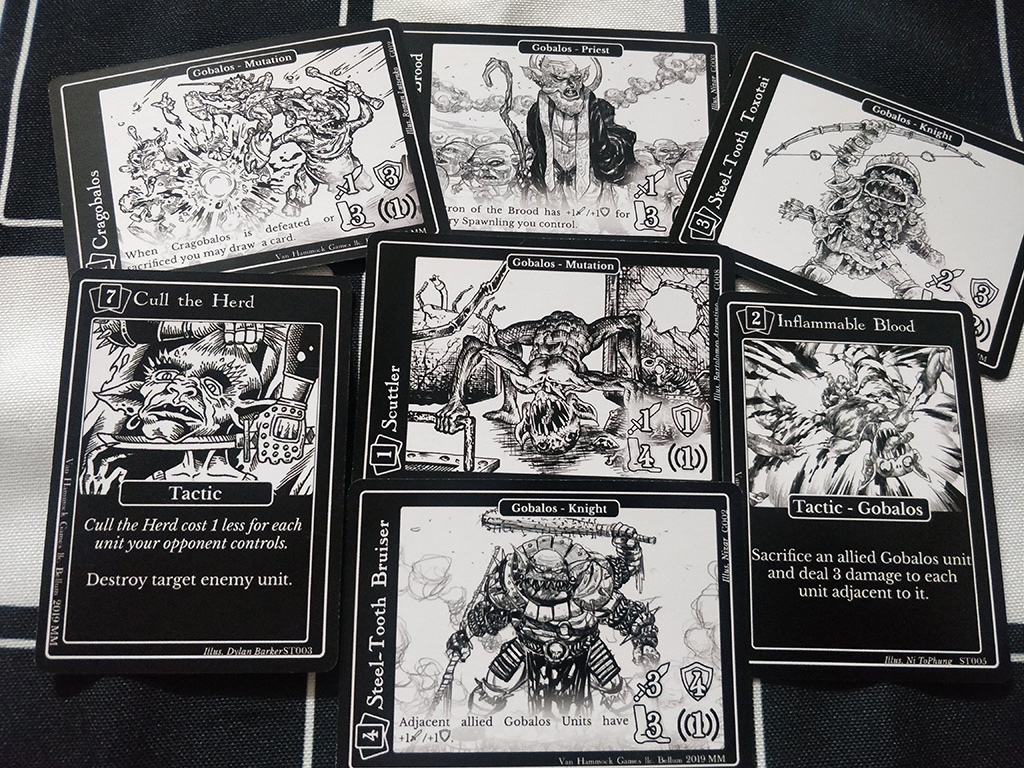
We particularly enjoyed the Gobalos Spawnlings which can be created by certain Gobalos Units. These are essentially ‘pawns’ that can be used for some extra defence or attack – although they are fairly weak and easy to destroy, they certainly fulfil the job of annoying your opponent.
As the game progresses you get closer to the opponents Keep and attacking this square is what ultimately wins the game. Every time the Keep is attacked it loses a health point which, again, is marked on a card using a counter. Players can keep Units on their keep in order to defend it but this can also limit their ability to field new cards into play. There are, however, some cards that can be stored on the Keep and have the added bonus that you can field a card elsewhere.
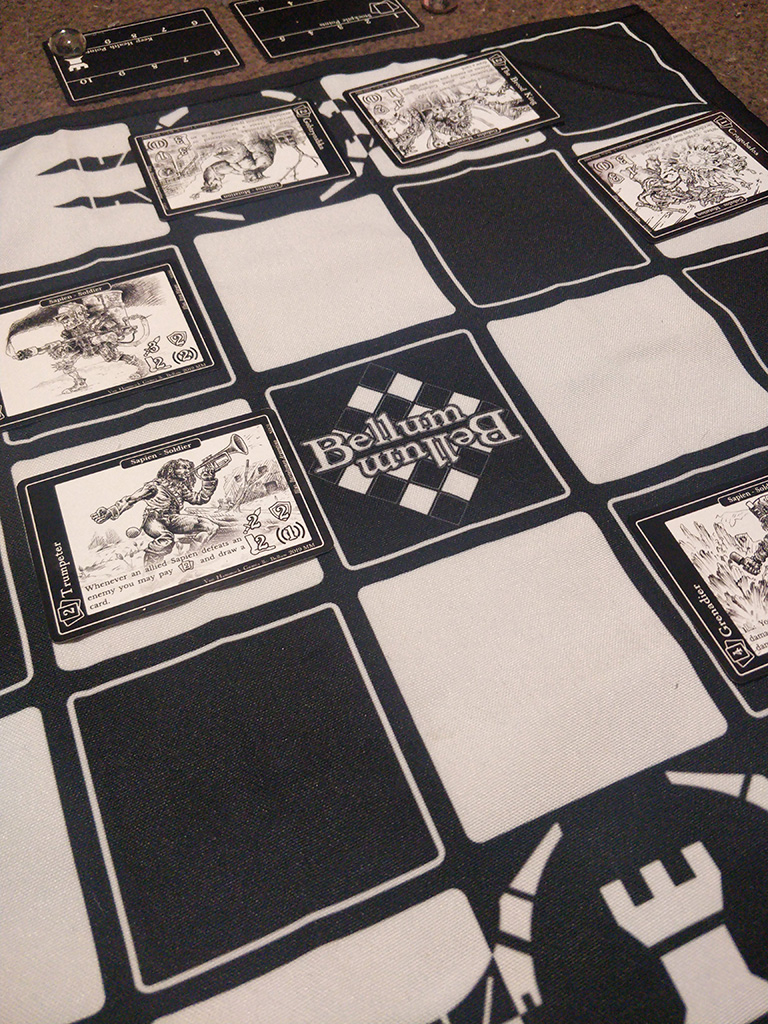
So, in terms of gameplay, that’s pretty much the gist of “Bellum: Of Mutants and Men”. Although it is actually easier to play than it seems from this write-up – so much so that us two card-game n00bs were able to play it without any real difficulties.
The real challenge is in creating your own decks and I would certainly recommend having a few games with the pre-built decks first to get a good grasp of the mechanics before attempting to create your own deck. There is a wide selection of Units and Strategem to choose from giving a myriad of variations (sorry, I really can’t be bothered doing the maths to work out how many different decks could be made from the included 250+ cards).
Our first game took considerably longer than the suggested 30 minutes but that was down to playing and learning at the same time as well being new to this type of game. The further games were around 30 to 45 minutes in length. Overall we enjoyed “Bellum: Of Mutants and Men” and found it fun game to play without being too complicated to put off newcomers to this genre but with enough variation for seasoned pro’s to sink their teeth into.
Big thanks to Van Hammock Games for providing us with the preview version of “Bellum: Of Mutants and Men“

